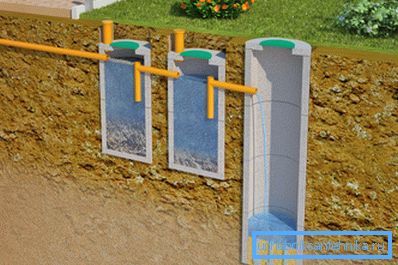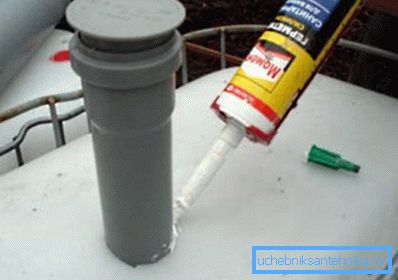Septic tanks for sewage - a key element of autonomous sewage
Not all country houses are located close to the centralized drainage system. In this connection, the problem of discharge of wastewater becomes urgent, the usual cesspool is not an option, because with permanent residence in the house you will have to divert too much wastewater. Plastic septic tanks for sewage can be a solution to this problem.

How does autonomous sewer work
The main difference of the autonomous sewage system from the usual one is that all wastewater is simply treated within the land plot and into the soil. In the centralized system, the sewage is simply discharged into the drainage system (see also the article Slope of the sewage pipe is an important indicator for efficient operation).

A septic tank for sewerage country houses allows you to clean the drains to about the level of industrial water.
Standard septic tank design solves the following tasks:
- At the first stage, drains are settled for 3 days without air access. Anaerobic bacteria are involved, in addition, large particles are deposited on the bottom;
- in the second tank, the main cleaning of the liquid takes place. Here oxygen is already needed, because the main work falls to the share of aerobic bacteria;
- thereafter, the effluent enters the normal drainage well and is absorbed into the ground.
Note! The quality of water purification is very important, especially if ground water is used for water supply at home. If the septic tank construction technology is not observed, the risk of water contamination is high, and therefore, the health of people falls into the risk zone.
What is the best septic tank for a country house
The choice in this matter has to do with an eye on the budget.
Will have to choose from the following options:
- ready plastic septic tank. It would be possible to call the optimal choice, if it were not for its price, and in terms of efficiency, it is not so very different from self-made counterparts;

- homemade septic tank of eurocubes - A good option for a country house. The size of the container can be chosen for any number of family members;
- prefabricated concrete ring or solid concrete construction. In terms of tightness and efficiency at a height, but the need to rent special equipment somewhat reduces the popularity of this type of septic tank;

- from truck tires. Such a sewer septic tank should not even be considered, it can only be suitable for the garden and then as a temporary option.
Considering the price, operational efficiency and ease of installation, designs using plastic containers remain unrivaled.
Regulatory aspects of the installation of a septic tank
It is necessary to take into account the recommendations of such documents as SNiP 2.04.03-85, as well as SanPiN 2.1.5.980-00 and 2.2.1 / 2.1.1.1200-03 - they indicate the general principles of the location of septic tanks.
You can navigate to the following maximum allowable distances:
- from the house a septic tank is installed no closer than 5 m;
- the distance to the road must be at least 5 m;
- it is better to remove the septic tank from the drinking well as far as possible, the optimal distance is 40 - 50 m;
- the stream should be at least 10 m, and the reservoir - 25-30 m.

Incorrect installation of a septic tank can lead to serious consequences, even problems with the law. Formally, the violation of the installation technology falls under Article 250 of the Criminal Code of the Russian Federation.
Technology device septic tank
Septic sewage in a private house is not such a rarity, and quite often the entire sewer system is made independently.
In principle, there is nothing difficult in this, it is recommended to adhere to the following procedure:
- digging holes under 2 plastic containers (for primary and secondary sewage treatment) and 1 well under the drainage well;
- a drainage pad is arranged at the bottom of the pits;

- in the tanks themselves are cut holes for the connecting pipes and ventilation;
- pits are installed, walls are strengthened if necessary;
- containers are installed in the pits, and they are backfilled.
All work can be done by hand without the involvement of special equipment.
Calculation of the required capacity
In case of centralized drainage, the volume of wastewater is thought out unless, when choosing the diameter of the pipeline, when using a septic tank, it is necessary to take into account that cleaning takes 3 days at least. That is, the tank should easily accommodate a 3-day volume of waste.
SNiP 2.04.09-85 the amount of wastewater binds to the degree of livability of the territory. So, for a house without a bath and hot water a day, you can take a flow of 125 l / person, but for houses with centralized heating and a bathroom, this figure rises to 350 l / person.

In a private house, you can take an intermediate option - 200 - 300 l / person per day. Thus, for 3 people, the volume of runoff per knock will be 600 - 900 l, and for 3 days - 1800 - 2700 l. In this case, autonomous sewage septic tank may look like a chain of 3 tanks (each for 1000 liters) or use 2 tanks of 1500 liters each.
Pit under the tank
The pit rummages with a small margin relative to the size of the tank. On each side, the distance from the pit wall to the tank wall should be at least 30 cm.
It should be borne in mind that the second tank height must be shifted 30-40 cm down relative to the first. Accordingly, a step is made at the bottom of the pit to provide this difference.

Note! Difference in height will allow maximum use of the second tank. If this requirement is neglected, then the calculated volume of tanks may not be enough.
A layer of rubble is laid on the bottom (10 - 15 cm), and on top - a layer of sand. The sandy layer must be thoroughly compacted, it is allowed to moisten the sand for this.
Tank preparation
Before installing in containers, you need to make all the necessary holes and seal them. Thick plastic is conveniently cut grinder.
First, the hole is made in the place where the sewer pipe will pass, then a hole is made in the second tank for the discharge pipe (the one that drops water into the drainage well). The most laborious can be called the installation of pipes for internal overflow.

In addition to the horizontal lintel in plastic tanks, it is also necessary to install tees, the septic system should work without interruption, this design will not allow the message to be broken. The problem is that often the tees do not crawl into the neck of the container. In this case, the technological hole is made, the overflow is arranged, and the hole itself is then sealed.

Without exception, the joints of plastic and pipes must be sealed. In addition, be sure to device several layers of waterproofing.
Installation of tanks
After placing the tanks in the pits, it is necessary to resolve the issue of thermal insulation and durability of the walls, the pressure of the soil can destroy them.
Instructions for solving this problem looks like this:
- for thermal insulation tanks lined with foam;

- then a knitted frame is installed from reinforcing bars and wire around the tank;
- the space between the walls of the pit and the tank is filled with concrete or filled with soil (the reinforcement cage is not needed in this case).

Note! At the time of filling the pit or concreting the walls of the tanks is better to fill with water. This will not allow the pressure on the walls to break the tightness of the containers.
As for the ventilation pipes, they are installed exactly above the tee inside the tank. Thanks to this, it will be possible to clean the overflow at any time.
The finishing touch can be considered the device of concrete slabs above the tanks. Although, in order not to create additional pressure on the plastic, it is possible to limit oneself to a boardwalk, a layer of hydro- and thermal insulation.

Cleaning septic tanks
The whole mass of chemicals for sewage treatment can be divided into 2 groups:
- bioseptics for sewage - such means as Sanex, ROEBIC, Micropan;
- antiseptics are quite aggressive chemicals, they are not afraid of hard water or detergents.
Bioseptics (or biobacteria) are completely harmless to the environment. In fact - these are microorganisms that actively break down human waste. To function, they need moisture and heat, so these means are best used in the sewage of a house intended for permanent residence.

But the antiseptic for sewage will retain its effectiveness at low temperatures. In addition, biobacteria can die if sufficiently aggressive substances (for example, detergents) get into the septic tank. With an antiseptic, this will not happen. The flip side of the medal is that such substances actively destroy the sewage system itself (metals are particularly affected), and the environment also bears some damage.
Summarizing
Properly arranged autonomous sewage or septic tank, able to work like a Swiss watch for many decades. At the same time, it is not at all necessary to buy an expensive septic tank from a well-known manufacturer (find out here how a rainwater drainage system is designed).
Even a self-made septic tank will perfectly cope with the task of recycling waste. The main thing - to comply with the technology of work during its installation.
The video in this article focuses on autonomous sewage systems for country houses.